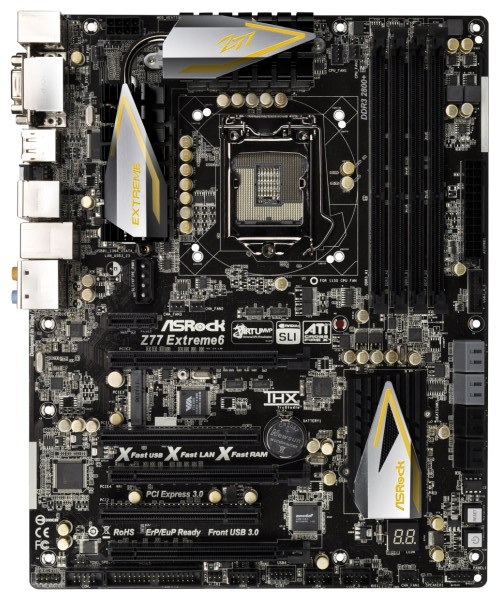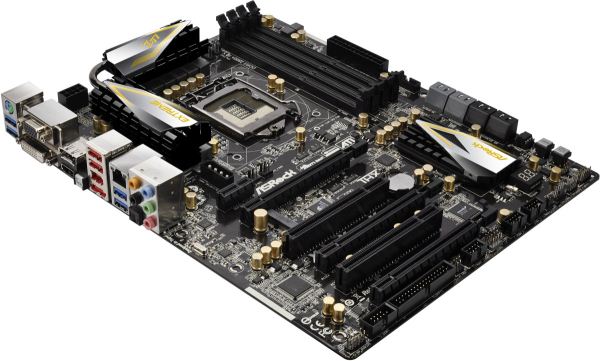Intel Z77 Panther Point Chipset and Motherboard Preview – ASRock, ASUS, Gigabyte, MSI, ECS and Biostar
by Ian Cutress on April 8, 2012 12:00 AM EST- Posted in
- Motherboards
- Intel
- Biostar
- MSI
- Gigabyte
- ASRock
- Asus
- Ivy Bridge
- ECS
- Z77
ASRock Z77 Extreme6—Visual Inspection
With the Extreme6, compared to the Extreme4, there are a significant number of changes, both visual and in terms of features. For a start, the heatsink design is more pronounced, using something similar to their X79 range in terms of black and gold ridged and edged surfaces. The VRM heatsink design is more substantial than the Extreme4, even though online it states it is still only an 8 + 4 VRM design—actually looking at the board, it seems more of a 10 + 4 design.
By looking at the motherboard, you would assume that it would support three-GPU setups. Unfortunately, this third full-length PCIe lane is only PCIe 2.0 x4, rather than splitting up the PCIe 3.0 lanes x8/x4/x4 or using a PLX chip. The MSRP for this board should be around $177, indicating that perhaps that is too cheap a board for one of the expensive PCIe 3.0 expansion PLX chips.

Onboard is also an mSATA port, right in the middle between the first PCIe slot and the PCI slot. Above the PCIe slots is a 4-pin molex power connector to provide extra power to the PCIe slots, although I am kind of getting tired of seeing it put in this location. If anything, it should be at the bottom end or beside the 24-pin power connector, as having it above the PCIe slots just means that there will be cables all over the place.
One other less obvious change to the Extreme4 is that there is a Floppy drive header on board. Yes, you heard me right—floppy drive! It seems odd now to include this legacy connection. It still has a place in industrial concepts (where a machine uses floppy drives and costs 1000x more than the PC processing its data), but not particularly on a higher end product which may be geared towards gaming and overclocking. Perhaps if ASRock are the only ones, then it creates a niche just for them.
In terms of fan headers on board, we have one three-pin beside the 8-pin 12V power connector, two CPU headers (one 4-pin, one 3-pin) just to the right of the top heatsink, two chassis three-pin headers beside the molex connector, and another 4-pin chassis header on the bottom of the board. On the right hand side, the USB 3.0 connector has been placed beneath the 24-pin ATX power connector, followed by the SATA ports. Like the Extreme4, we have the PCH SATA ports (two SATA 6 Gbps and four SATA 3 Gbps) and two extra SATA 6 Gbps from an ASMedia ASM1061 controller.
Around the larger chipset heatsink, we have power/reset buttons and a two digit debug display, both of which I personally like to see as a reviewer (makes my job a bit easier) but also helps overclockers. On the south side of the board, apart from that floppy connector I mentioned, we have a COM port, front panel audio, and an array of USB 2.0 headers.
PCIe layout is similar to the Extreme6, with a PCIe x1, PCIe 3.0 x16/x8, an mSATA connector, PCI, PCIe 3.0 x8, PCI, and a PCI 2.0 x4. This allows a user to use a dual GPU setup, and still have access to a PCIe x1 and x4.

Aside from the bowed picture from ASRock, we have something similar to the Extreme4 for the IO back panel, though this time with a DisplayPort output. From left to right, we have a combination PS/2 port, two USB 3.0 ports (blue), a D-Sub port, DVI-D, DisplayPort, HDMI, a ClearCMOS button, two USB 2.0 (red), an IEEE1394 port, eSATA, gigabit Ethernet, two more USB 3.0 (blue), and audio outputs including an optical SPDIF.
Board Features
| ASRock Z77 Extreme6 | |
| Size | ATX |
| CPU Interface | LGA-1155 |
| Chipset | Intel Z77 |
| Power Delivery | 8 + 4 |
| Memory Slots |
Four DDR3 DIMM slots supporting up to 32 GB Up to Dual Channel, 1066-2800 MHz |
| Video Outputs | DisplayPort, HDMI 1.4a, DVI-D, D-Sub |
| Onboard LAN | Broadcom BCM57781 |
| Onboard Audio | Realtek ALC898 |
| Expansion Slots |
2 x PCIe x16 Gen3 (x16, x8/8) 1 x PCIe x16 Gen2 (x4) 1 x PCIe x1 Gen2 2 x PCI 1 x mini PCIe |
| Onboard SATA/RAID |
2 x SATA 6 Gbps (PCH), Support for RAID 0, 1, 5, 10 2 x SATA 6 Gbps (ASMedia ASM1061) 4 x SATA 3 Gbps (PCH), Support for RAID 0, 1, 5, 10 |
| USB |
Two USB 3.0 at rear (PCH) Two USB 3.0 at rear (Etron EJ168A) One USB 3.0 header (PCH) |
| Onboard |
4 x SATA 6 Gbps 4 x SATA 3 Gbps 1 x Floppy Connector 1 x IR Header 1 x CIR Header 1 x COM Header 1 x SPDIF Header 1 x 4-pin Molex power connector Power/Reset Buttons Two Digit Debug LED 6 x Fan Headers Front panel audio connector 3 x USB 2.0 headers (support 6 USB 2.0 ports) 1 x USB 3.0 header (supports 2 USB 3.0 ports) |
| Power Connectors |
1 x 24-pin ATX connector 1 x 8-pin 12V connector 1 x 4-pin Molex for PCIe |
| Fan Headers |
2 x CPU Fan Header (one 4-pin, one 3-pin) 3 x CHA Fan Headers (one 4-pin, two 3-pin) 1 x SYS Fan Header (one 3-pin) |
| IO Panel |
1 x Combo PS/2 Port 1 x DisplayPort 1 x HDMI 1.4a 1 x DVI-D 1 x D-Sub 1 x Optical SPDIF 2 x USB 2.0 4 x USB 3.0 1 x IEEE1394 1 x Gigabit Ethernet 1 x Clear CMOS Audio Outputs |
| Warranty Period | 3 years from date of purchase |
| Product Page | Link |
Nothing immediately jumps out from the board features list aside from the differences to the Extreme4. This is a quite good package for an MSRP of $171.











145 Comments
View All Comments
LancerVI - Sunday, April 8, 2012 - link
They've yet to fail me. I think I may take the plunge with Ivy Bridge. My 920 X58 build has served me well, but I have the itch and I've avoided scratching it since late 2008. I don't think I can hold off any longer!!!I feel the need for a new build.....NOW!!!
TrackSmart - Sunday, April 8, 2012 - link
Ha ha. We all get the rational or irrational urge to upgrade, whether we 'need' it or not. I would never stop someone from enjoying a new build. But that being said, the core i7 920 still holds its own pretty well. However, I suppose quicksync alone could be worth the upgrade if it is a feature you use heavily. That is one area where the performance gains are just phenomenal.ImSpartacus - Sunday, April 8, 2012 - link
Shoot, I'm still rolling with an E8400. You're 920 has some legs.Unless you have a killer app in Ivy Bridge, just sit on your Nahalem machine.
LancerVI - Sunday, April 8, 2012 - link
Believe me fellas. This is all irrational and I'm not ashamed to admit it!mgl888 - Wednesday, April 11, 2012 - link
Like :)I'm torn between waiting for Haswell next or upgrading to Ivy Bridge now.
I'm on a E7200. Hahaha
Artifex28 - Monday, April 16, 2012 - link
...and I am burning this E6750. :DI give up. Time to upgrade. :)
prophet001 - Monday, April 9, 2012 - link
Hmm...Rockin the Core 2 on the 975x with an 8800 gtx here :D
LancerVI - Monday, April 9, 2012 - link
That's awesome! That's a great setup! The 8800GTX is on par, in my mind, with the 9700 Pro of yore.jbuiltman - Tuesday, April 10, 2012 - link
920 X58 being slow???? I have an AMD FX-60 Dual core with 2GB of DDR ram....That is slow.... :)LancerVI - Thursday, April 12, 2012 - link
Who said anything about being slow?? All I'm saying is I haven't built a new machine since 2008 and I have the itch.I realize it's a slight up grade or maybe even considered a side-grade, but it's an itch. I'll probably wait unitl Ivy Bridge-E and then see.